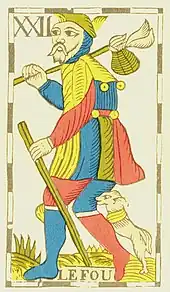
The Cartes de Suisses are an 18th century standard pattern of Tarot playing cards that were initially produced in Switzerland, but later in the Austrian Netherlands, now part of Belgium. As a result they are also referred to as the Flemish Tarot or the Belgian Tarot.[1][2]
History
Background
Tarot playing cards emerged in the early 15th century in northern Italy, the first documented packs being associated with Milan, Ferrara, Florence and Bologna when an additional set of trumps known as trionfi were added to a standard, Italian-suited pack with the four suits: Swords, Batons, Cups and Coins.[3][4] The earliest surviving examples are the Visconti-Sforza Tarot packs painted in the mid-15th century for the Dukes of Milan.[5]
Because the earliest tarot cards were hand-painted, they were probably only produced in small numbers. However, the advent of the printing press enabled the mass production of cards and their spread elsewhere. The expansion of tarot outside of Italy, first to France and Switzerland, occurred during the Italian Wars. The most prominent tarot deck version used in these two countries was the Tarot of Marseilles, of Milanese origin.[6]
Emergence and spread of Cartes de Suisses
In the late 16th century a heavy French tax on playing card manufacture drove many cardmakers to emigrate to Switzerland where they created a new design of tarot pack that became known as Cartes de Suisses.[7] This pattern was adopted by cardmakers in the Austrian Netherlands perhaps as a result of the spread of a Swiss tarot card game, such as Troggu, to that part of the world during the 18th century. At that time this design became a standard pattern there in the 18th century, the name Cartes de Suisses being retained.[8] In 1849, for example, a pack of "Swiss Tarots, Cartes de Suisses" is advertised for sale in a catalogue. The description notes that it was made in Brussels by F. J. Vandenborre, cardmaker, and comprises 78 cards, "the Coat Cards are exceedingly curious, representing Bacchus, Love, Death, the Devil, Lightning, Sun, Moon, Stars, Day of Judgement, Fool, &c."[9]
The name Flemish Tarot was given because the cards were made in the Flemish-speaking part of the Austrian Netherlands.[7]
Cards
The Cartes de Suisses pattern is more primitive than the Tarot de Marseilles, its key distinguishing features being:[7]
- Tarot II: The Popesse is replaced by "L'Espagnol. Capitano Eracasse", a swaggering Spanish captain
- Tarot V: The Pope is replaced by Bacchus (spelt "Bacus") the god of wine.
- Tarot XII: The inscription for the Hanged Man (Le Pendue) is spelt Lepen-du.
- Tarot XVI: The House of God (Maison Dieu) is replaced by "Lightning" (La Foudre).
- Tarot XXII: The Fool is, unusually, numbered, perhaps because it had recently been promoted to the top card (see Troggu)
The designs on many of the tarots have also been changed. For example, The Star depicts a seated astronomer instead of a kneeling woman.[7]
The pictures below portray the 22 trump cards of the Cartes de Suisses:
 Le Bateleux
Le Bateleux LE'spagno - Capitano Eracasse
LE'spagno - Capitano Eracasse L'Imperatris
L'Imperatris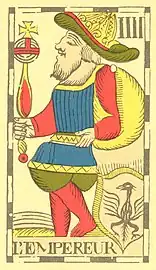 L'Empereur
L'Empereur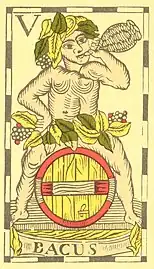 Bacus
Bacus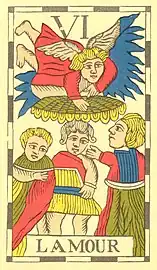 L'Amour
L'Amour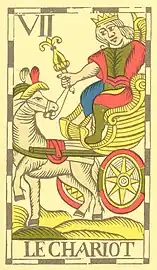 Le Chariot
Le Chariot La Justice
La Justice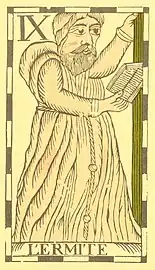 L'Ermite
L'Ermite Roue de Fortune
Roue de Fortune La Force
La Force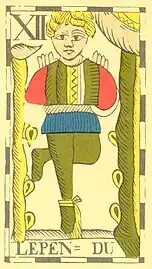 Lepen-Du
Lepen-Du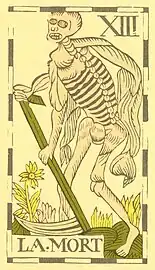 La Mort
La Mort La Temperance
La Temperance Le Diable
Le Diable La Foudre
La Foudre LE'toille
LE'toille La Lune
La Lune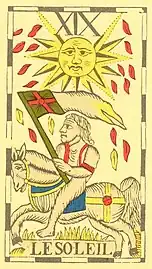 Le Soleil
Le Soleil Le Jugement
Le Jugement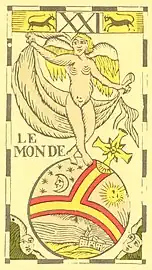 Le Monde
Le Monde Le Fou
Le Fou
References
- ↑ Depaulis (1984), p. 57.
- ↑ Vandenborre Tarot at wopc.co.uk. Retrieved 12 November 2023.
- ↑ Pratesi (2012), p. 100
- ↑ Pratesi, Franco. Studies on Giusto Giusti Archived 2021-02-24 at the Wayback Machine at trionfi.com. Retrieved 4 February 2018.
- ↑ Depaulis, Decker & Dummett (1996), p. 25.
- ↑ Dummett (1980).
- 1 2 3 4 Kaplan (1978), p. 192.
- ↑ Dummett & McLeod (2004). pp. 403–413.
- ↑ Smith (1849), p.57.
Bibliography
- Depaulis, Thierry (1984). Tarot: Jeu et Magie. Paris: Bibliothèque Nationale.
- Decker, Ronald, Depaulis, Thierry and Sir Michael Dummett (1996). A Wicked Pack Of Cards. ISBN 9780312162948
- Dummett, Sir Michael (1980). The Game of Tarot: From Ferrara to Salt Lake City ISBN 9780715610145
- Dummett, Sir Michael and John McLeod (2004). A History of Games Played with the Tarot Pack. Lewiston: Edwin Mellen Press.
- Kaplan, Stuart R. (1978). Encyclopedia of Tarot, Vol. 2. Stamford, CT: US Games Systems. ISBN 0-913866-36-9
- Pratesi, Franco (2012). "In Search of Tarot Sources". The Playing-Card. 41 (2): 100.
